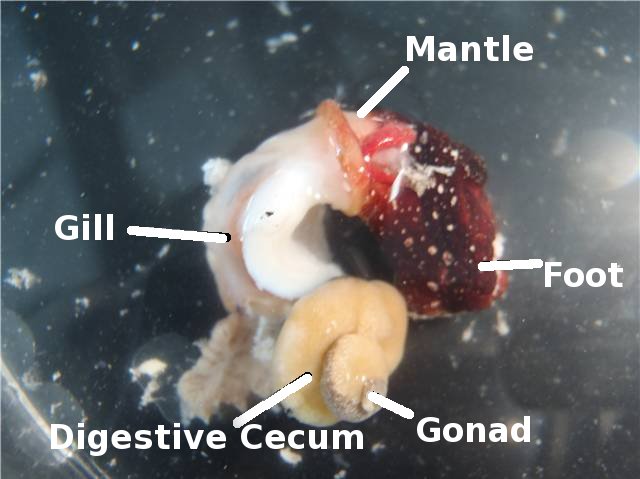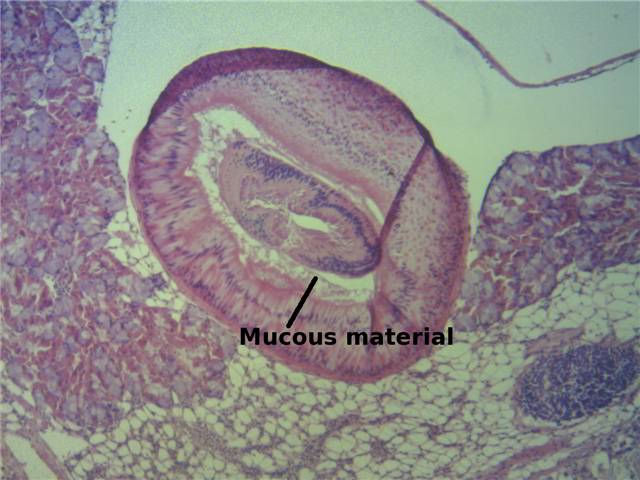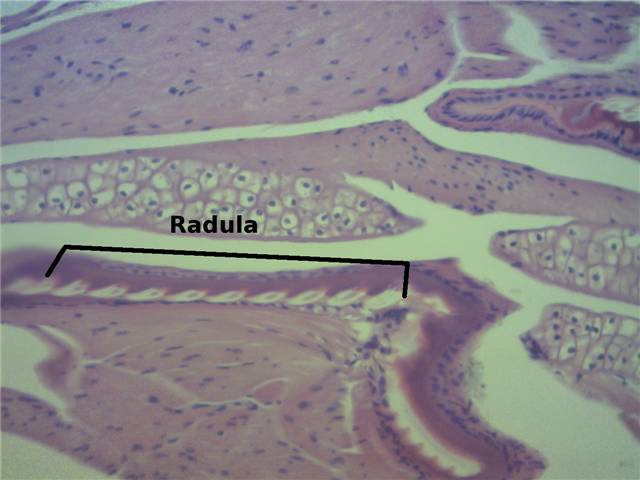Overview
Brief Summary
Distribution
Physical Description
Size
Identification Resources
Ecology
Local Distribution and Habitats
Life History & Behaviour
Behaviour
Reproduction and Development
Evolution & Systematics
Systematics or Phylogenetics
Morphology and Physiology
External Morphology
Internal Anatomy
Conservation
Trends and Threats
References & More Information
Bibliographies
Search the Web
Names & Taxonomy
Synonyms | Internal Anatomy
 Image 1 shows the Latirus polygonus exposed from its shell. The mantle skirt is visible along with the gill. The members of Neogastropoda only have one monopectinate gill (Ruppert 2004). The digestive cecum is the yellowish spiral tube located in the further posterior region, which would be around the spire of the shell when not exposed. The gonad is at the very tip of the posterior part of the body, which has a brownish colouration. This would be located around the apex when not exposed. Image 1 shows the Latirus polygonus exposed from its shell. The mantle skirt is visible along with the gill. The members of Neogastropoda only have one monopectinate gill (Ruppert 2004). The digestive cecum is the yellowish spiral tube located in the further posterior region, which would be around the spire of the shell when not exposed. The gonad is at the very tip of the posterior part of the body, which has a brownish colouration. This would be located around the apex when not exposed.
The gut in the case of the L. polygonus, is a simple sac as in all Neogastropods. Since they are carnivorous, many have poison glands to aid in hunting for prey, but it is uncertain whether L. polygonus have this as well.
Image 1. Latirus polygonus exposed from shell.
 Carnivorous species of gastropods in most cases have two highly specialized structures to enhance their hunting and feeding capabilities. These are the proboscis and the radula. The proboscis in carnivorous gastropods are highly extensible, and can protrude to feed on prey. It is part of the digestive tract and includes the esophagus, buccal cavity, and the radula. They have different adaptations among the carnivorous gastropods as well, where some may have special cells to enhance survey abilities to search for prey, or simply to have a longer range of feeding area. Image 2 is a photo of a stained and sectioned proboscis of L. polygonus. The mucous material secreted inside is visible, which is most likely to aid in digestion of the obtained food material. Carnivorous species of gastropods in most cases have two highly specialized structures to enhance their hunting and feeding capabilities. These are the proboscis and the radula. The proboscis in carnivorous gastropods are highly extensible, and can protrude to feed on prey. It is part of the digestive tract and includes the esophagus, buccal cavity, and the radula. They have different adaptations among the carnivorous gastropods as well, where some may have special cells to enhance survey abilities to search for prey, or simply to have a longer range of feeding area. Image 2 is a photo of a stained and sectioned proboscis of L. polygonus. The mucous material secreted inside is visible, which is most likely to aid in digestion of the obtained food material.
Image 2. Stained and sectioned proboscis of L. polygonus.

The radula is highly modified in carnivorous gastropods as well, with enhanced abilities to cut, grasp, tear or scrape food material. Simple jaws may be observed in some cases as well, but it is uncertain for L. polygonus. Image 3 is a photo of a stained and sectioned part of the radula of L. polygonus. The lined up teeth like structures are clearly visible. L. polygonus are classified as a member of the Muricoidea, indicating that they must have a radula with three teeth. The highly modified radula in Neogastropods are in most cases used in a combination with an eversible proboscis.
Image 3. Stained and sectioned part of the radula of L. polygonus.
Excretion in marine gastropods are done by diffusing ammonia across the body and gill surface. In such cases where ammonia is the final waste product of the protein metabolism, the organism is considered to be ammonotelic. In the case of intertidal species like the L. polygonus, they may change to and from ammonotelic and uricotelic (mode of excretion for terrestrial and some freshwater species), depending on the tidal conditions and the availability of water.
Internal transport for marine gastropods are mostly the same with the generalized mollusc hemal system. This consists of the heart, aorta, blood vessels, hemolymph (blood), and hemocoel. The hemolymph contains both the amebocytes and respiratory pigments. The only difference to point out is that the position of the heart has changed in most species and have only one atrium.
The nervous system for gastropods is considered to be similar to the generalized mollusc nervous system as well. The central nervous system is composed by several ganglia bundled up together, with a brain to process the information. The only difference to point out is that the gastropods have a tendency to have a more cephalized nervous system, rather than being bilaterally symmetrical. Sensory organs of gastropods include the eye, tentacles, osphradia, statocysts, and a magnetic sensory system that varies widely in the development and usage between species. The osphradium of prosobranchs are highly developed to have chemosensory capabilities, but there is recent speculation that they may have other functions as well.
|
|